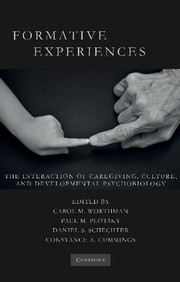Book contents
- Frontmatter
- Contents
- List of Figures
- List of Tables
- List of Contributors
- Foreword by Robert Sapolsky
- Preface
- List of Abbreviations
- Introduction
- SECTION ONE HISTORICAL, CROSS-CULTURAL, AND DEVELOPMENTAL SCIENCE PERSPECTIVES
- SECTION TWO HOW EXPERIENCE INTERACTS WITH BIOLOGICAL DEVELOPMENT
- SECTION THREE FORMATIVE RELATIONSHIPS WITHIN AND ACROSS GENERATIONS
- SECTION FOUR SOCIAL AND CULTURAL CONTEXTS OF CHILDHOOD DEVELOPMENT – NORMATIVE SETTINGS, PRACTICES, AND CONSEQUENCES
- SECTION FIVE FEAR, FUN, AND THE BOUNDARIES OF SOCIAL EXPERIENCE
- 15 Ethnographic Case Study: Anak PKI – A Longitudinal Case Study of the Effects of Social Ostracism, Political Violence, and Bullying on an Adolescent Javanese Boy
- Commentary
- Commentary
- 16 The Evolution of Social Play
- 17 Ethological Vignette: Social Stress as a Formative Experience – Neurobiology of Conditioned Defeat
- Commentary
- Commentary
- Commentary
- 18 The Basic Affective Circuits of Mammalian Brains: Implications for Healthy Human Development and the Cultural Landscapes of ADHD
- SECTION SIX PUBLIC HEALTH, EDUCATION, AND POLICY IMPLICATIONS
- Index
- References
Commentary
Published online by Cambridge University Press: 26 May 2010
- Frontmatter
- Contents
- List of Figures
- List of Tables
- List of Contributors
- Foreword by Robert Sapolsky
- Preface
- List of Abbreviations
- Introduction
- SECTION ONE HISTORICAL, CROSS-CULTURAL, AND DEVELOPMENTAL SCIENCE PERSPECTIVES
- SECTION TWO HOW EXPERIENCE INTERACTS WITH BIOLOGICAL DEVELOPMENT
- SECTION THREE FORMATIVE RELATIONSHIPS WITHIN AND ACROSS GENERATIONS
- SECTION FOUR SOCIAL AND CULTURAL CONTEXTS OF CHILDHOOD DEVELOPMENT – NORMATIVE SETTINGS, PRACTICES, AND CONSEQUENCES
- SECTION FIVE FEAR, FUN, AND THE BOUNDARIES OF SOCIAL EXPERIENCE
- 15 Ethnographic Case Study: Anak PKI – A Longitudinal Case Study of the Effects of Social Ostracism, Political Violence, and Bullying on an Adolescent Javanese Boy
- Commentary
- Commentary
- 16 The Evolution of Social Play
- 17 Ethological Vignette: Social Stress as a Formative Experience – Neurobiology of Conditioned Defeat
- Commentary
- Commentary
- Commentary
- 18 The Basic Affective Circuits of Mammalian Brains: Implications for Healthy Human Development and the Cultural Landscapes of ADHD
- SECTION SIX PUBLIC HEALTH, EDUCATION, AND POLICY IMPLICATIONS
- Index
- References
Summary
The chapter by Kim Huhman, “Social Stress as a Formative Experience: Neurobiology of Conditioned Defeat,” is a very interesting description of conditioned defeat in Syrian hamsters as a model of understanding the neurobiology of social stress and its effects on stress-related disorders in humans. This commentary will describe recent data from a large sample of inner-city at-risk subjects who have experienced an enormous amount of inter-personal violence. We find that these traumatic experiences, both in adulthood and childhood, contribute greatly to adult posttraumatic stress disorder (PTSD) and depression. Furthermore, we will describe data suggesting that early unstable family environments in this population are a significant risk factor for these adult stress-related disorders, whereas nurturing caregiving appears to be protective. Finally, we refer to recent data that social support in adulthood appears to be a resiliency factor helping to mediate against the effects of child abuse on adult depression.
IMPORTANCE OF INTERPERSONAL VIOLENCE AS A CRITICAL MEDIATOR OF STRESS-RELATED DISORDERS
Among civilians, inner-city minority populations appear to be exposed to extreme amounts of trauma (Breslau et al., 1998; Alim, Charney, & Mellman, 2006). For example, economically disadvantaged African Americans living within urban environments experience high levels of inter-personal violence and trauma (Breslau, Davis, Andreski, & Peterson, 1991; Shakoor & Chalmers, 1991; Fitzpatrick & Boldizar, 1993; Breslau et al., 1998; Selner-O'Hagan, Kindlon, Buka, Raudenbush, & Earls, 1998). Furthermore, a large amount of this exposure occurs during youth (Shakoor et al., 1991; Fitzpatrick et al., 1993; Selner-O'Hagan et al., 1998).
- Type
- Chapter
- Information
- Formative ExperiencesThe Interaction of Caregiving, Culture, and Developmental Psychobiology, pp. 451 - 462Publisher: Cambridge University PressPrint publication year: 2010
References
- 1
- Cited by



